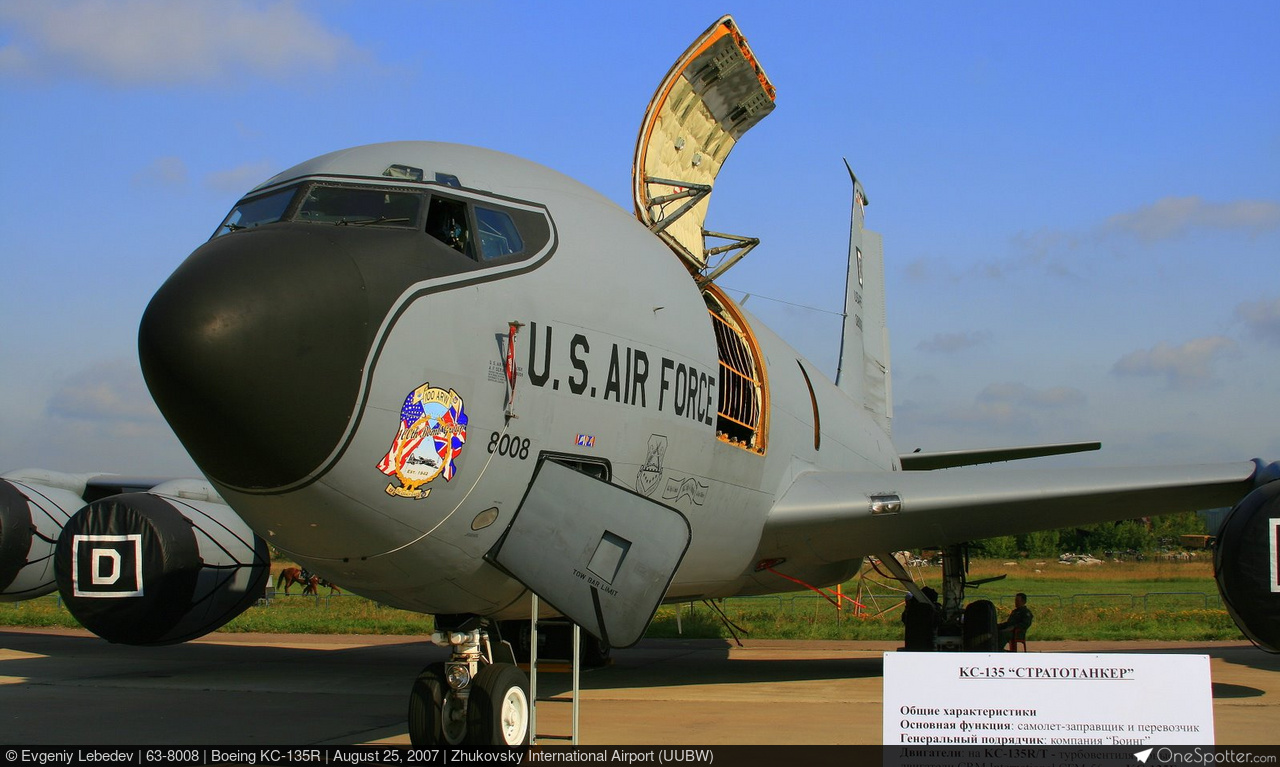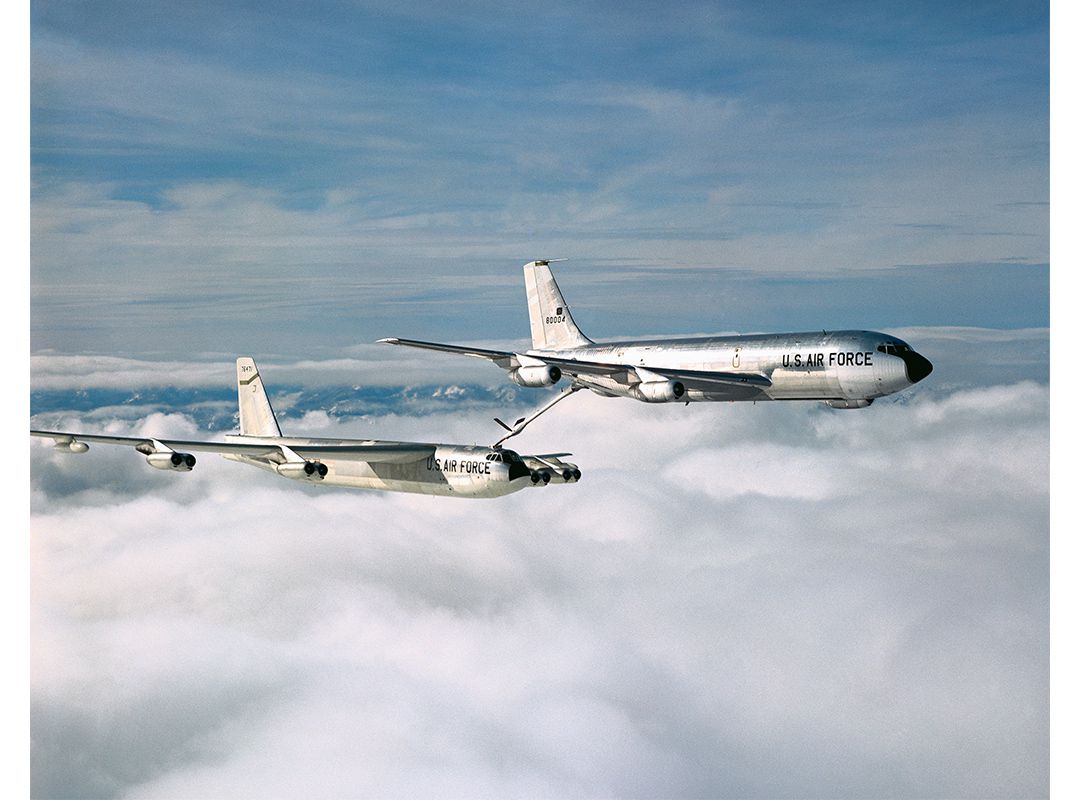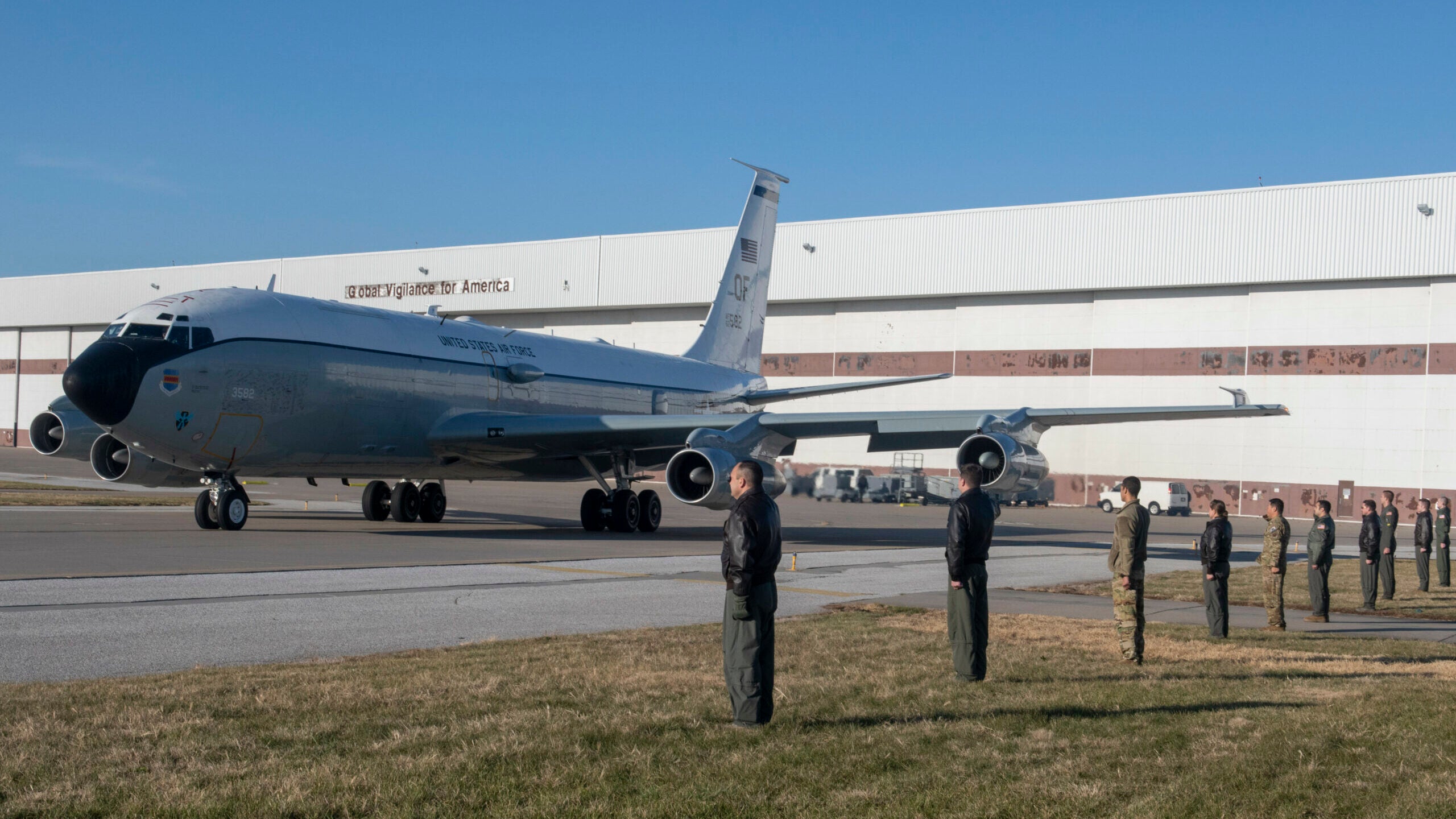C 135 Aircraft - Originally delivered in natural metal, the KC-135 has had relatively few color schemes. Coroguard was eventually applied to limit corrosion, later followed by a light grey. In the 1980s, Strategic Air Command (SAC) was concerned about tankers over Europe being shot down while in support of NATO, which prompted the hideously ineffective "Shamu" scheme of dark grey-green.
This might have helped hide the KC-135 when viewed from above over cloudless terrain, but it made the jet more visible in the air and played havoc with the interior heat. In an effort to ensure DoD support for the 1963 Partial Test Ban Treaty, Congress approved the purchase of three Early Day/Rivet Digger NC-135As as part of the National Nuclear Test Readiness Program (NNTRP).
C 135 Aircraft

Each one was configured by the three U.S.A. atomic labs: Los Alamos Diagnostic Lab, Sandia National Lab, and the Lawrence Livermore National Lab. Each carried a variety of nuclear sensors, high-speed cameras, and technical equipment. Two—60-0369 and 60-0370—lacked all markings on the right side, while 60-0371 was unmarked on the left side to avoid flash burns to the paint from any of the fireball.
Retired Airliner Military Workhorse
This proved unnecessary, but the paint scheme was retained anyway. The original "Weightless Wonder" zero-gravity simulator was a Convair C-131, but the availability of spare KC-135s allowed for longer-duration training flights. Three different C/NKC/KC-135As were used at Wright-Patterson Air Force Base, Ohio, but by 1974 the Air Force wanted to diversify the zero-g mission to NASA.
KC-135A 59-1481 had a terrible maintenance record, which is why the Air Force offered it to NASA. That agency, not surprisingly, declined. After much bureaucratic wrangling and extensive repairs, however, it went on to fly 57,667 parabolas over its 22-year career.
It would also support Space Shuttle transport flights alongside NASA's 747s. Boeing modifications that extended service capabilities of the KC-135s included re-skinning the wings with an improved aluminum alloy and installing new, more powerful and fuel-efficient engines.
Two re-engined KC-135Rs could do the work of three KC-135As. Along with KC-135A N98 (59-1481 which went to NASA), what it found while executing its research mission was appalling, as the procedures and how the airways operated were designed for the previous generation of piston-powered airliners.
Origins And Operational History
As such, today's air travel owes its safety to the two FAA KC-135As. N96 eventually returned to the Air Force in 1979 for conversion into an EC-135K Head Dancer airborne command post. Sebastien Roblin has written on the technical, historical, and political aspects of international security and conflict for publications including 19FortyFive, The National Interest, MSNBC, Forbes.com, Inside Unmanned Systems and War is Boring.

He holds a master's degree from Georgetown University and has served with the Peace Corps in China. You can follow his articles on Twitter. When originally delivered, the KC-135 was equipped with Pratt & Whitney J57 engines.
These used water injection to increase available thrust on initial take-off, but were nonetheless woefully inadequate in terms of overall performance and fuel consumption. Indeed, there were some emergency situations where the KC-135 could neither climb nor accelerate after takeoff, all but guaranteeing the loss of a jet and its crew.
One of these was the unique RC-135E Lisa Ann, later known as Rivet Amber. He carried a version of the massive Hughes radar installed on the island of the USS Enterprise to track incoming Soviet warheads to the Klyuchi Test Range on the Kamchatka Peninsula, and steered a Ballistic Streak Camera that filmed the event.
The radar and associated equipment were far too big to fit in the jet, so the Big Safari conversion team extended the fuselage by 18 inches. No, this wasn't the advent of the longer "hog" nose on the RC-135, but a stretch of the actual fuselage—prompting Boeing to disavow all responsibility for the airframe.
Interestingly, JKC-135A 55-3128 was involved with tests of wingtip-mounted rocket pods. Official records have yet to be uncovered that reveal exactly what these were, but they may well have been associated with test of the forward-firing AN/ALE-25 chaff rocket pods for the B-52.
Although most of the remaining C-135 aircraft are used for transporting senior military leaders and other high-ranking dignitaries, the C-135C communications aircraft serves as an aerial test-bed for emerging technologies. Developmental tests using this aircraft have demonstrated the capability to fly precision approaches using a local area differential GPS system.
This modified C-135 has been fitted with a millimeter wave camera and a radome to test the camera's generation of video images of the forward scene in low-visibility conditions. The aircraft, which in the VIP/Distinguished Visitor (DV) transport role seats 14 passengers, also gives a Joint Forces Air Component Commander (JFACC) a limited ability to plan and control the simulated battle while in the air en route to the crisis area.

. Speckled Trout is the official name of a combined SAF/CSAF support mission and concurrent test mission. It was also the official nickname given to a modified C-135C, serial number 61-2669, that was used by the Secretary and Chief of Staff of the Air Force for executive transport requirements.
Fully equipped with an array of communications equipment, data links and cryptographic sets, the aircraft served a secondary role as a test bed for proposed command and control systems and was also used to evaluate future transport aircraft design.
The 412th Flight Test Squadron (412 FLTS) of the Air Force Materiel Command (AFMC) at Edwards AFB, California operated the C-135 Speckled Trout airframe and managed its test mission. The name Speckled Trout applies to both the organization and the aircraft.
The name was chosen in honor of an early program monitor, Faye Trout, who assisted in numerous phases of the project.[10] Trout reportedly had many freckles, hence the addition of "Speckled." During the early years of the US space program, scientists and engineers sought to understand the survivability of spacecraft as they exited and then re-entered the atmosphere.
Several programmes, such as the two JKC-135As that took part in Operation Skyscraper, tracked unmanned spacecraft immediately after launch and during re-entry. Beyond the pure research and “space race” benefits of these flights, there was a significant, but unmentioned, military component.
The C-135F was new-built variant by France as dual-role tanker/transport aircraft.[12] 12 were built for the French Air Force with the addition of a drug adapter on the refueling boom. Given Boeing model numbers 717-164 and 717-165.
11 surviving C-135Fs upgraded to C-135FRs with CFM International F108 turbofans between 1985 and 1988. Later modified with MPRS wing pods.[citation needed] Jets with the non-conformal pins must have the component replaced at a depot—in most cases at the Oklahoma City Air Logistics Complex.

Even then, the fix doesn't require removing the entire tail and takes only a day—unless there's damage to the lugs. A total of 820 C/KC-135s were built in Renton, Wash., through 1966: 732 as aerial tanks and 88 modified for special purposes, including cargo carriers, reconnaissance airplanes, Strategic Air Command airborne command posts and transports for high-ranking
government officials. Beginning with the October 31st, 1961 Tsar Bomba detonation monitored by JKC-135A 55-3127—it was not 20 miles away, but that's another story—KC-135 variants have been used to assess dozens of atmospheric atomic tests from the United States,
Soviet Union, and even France. Tragically, the RC-135E and 19 souls disappeared over the Bering Sea on 5th June 1969, likely the result of the failure of the vertical stabilizer following damage from severe turbulence during an operational mission the previous day.
On Feb. 24, 2011, Boeing announced that it had received a contract from the U.S.A. Air Force to build the next-generation aerial refueling tanker aircraft, the KC-46, based on the Boeing 767 commercial airplane, to replace 179 of the service's 400 KC-135 tankers.
Efforts such as the Radiation Monitoring Program (RAMP) and Terminal Radiation Program (TRAP) built a database of American—never Soviet—missile and re-entry vehicle (warhead) infrared signatures. This would allow targeting of Soviet ICBMs during the boost phase, including by Kelly Johnson's proposed Low Card laser-equipped U-2s hovering around the USSR, and incoming warheads.
The KC-135 was the first offspring of the Dash 80. It was designed specifically for aerial refueling and for 15 years was the only tank used by the Strategic Air Command. More than 600 of the 732 tankers built were still in service in the mid-1990s.
The KC-135 replaced the propeller-powered KC-97 tanks, which could no longer keep up with the jet fighters and bombers. In 1956, when the first KC-135 — nicknamed "The City of Renton" — rolled out of the plant, it shared the Renton tarmac with the last KC-97, providing a vivid picture of The Boeing Company's complete conversion to jet power.
A large majority of the 820 -135 units built were KC-135A Stratotankers, used for mid-air refueling. Forty-five base-model aircraft were built as C-135A or C-135B transports with the tanking equipment excluded. As is the case with the KC-135, the C-135 is also recognized as the Model 717 by Boeing.[7]
Since its first flight on August 31st, 1956, there have been more than 80 variants of the KC-135A. For some of these, the differences were minor and often reflected only internal changes. For others, modifications significantly altered the appearance of the jet.
In tribute to these many versions, The War Zone presents—as Rod Serling would say—for your consideration a dozen versions of the weird and wonderful. Selecting just 12 was insanely difficult, especially as the many testbed variants could easily account for twice that many.
Overall, while the severity of the flaws with non-conformal pins hasn't been fully assessed, it's at least encouraging that the Air Force acted so aggressively to preempt potential problems before they manifest in more dramatic fashion.
According to the Omaha World-Herald, by February 19 all of the WC-135 and RC-135 surveillance jets based at Offut Airbase in Nebraska were reportedly verified not to use the suspect pins, and able to resume flight ops.
That included two Cobra Ball spy planes sent on February 20 to observe a failed test of Russia's latest silo-based nuclear missile. Thirty C-135Bs (Boeing model number 717-157/158) were built new with the TF33 turbofan and improved wide-span horizontal stabilizers.
Ten were modified for a weather reconnaissance (flying through radioactive clouds from nuclear tests or other agents) role and designated WC-135B Stratolifter (Constant Phoenix in later versions). Additional airframes were converted to RC-135s from the 1970s to 2006, and remain in service with further equipment upgrades installed.
![Boeing Kc-135 Stratotanker - Buy Royalty Free 3D Model By Tim Samedov (@Citizensnip) [4Ccd8f4]](https://media.sketchfab.com/models/4ccd8f4b156e4fb4ab23ecdd0c247ce4/thumbnails/b7143380a6ad4f97b1054867134ea380/d4145ca37efd40de9508b1b246b4452a.jpeg)
For tests with the YAL-1 747 laser platform, big crow NKC-135E 55-3132 acted as the target, simulating an incoming ballistic missile. To make sure the YAL-1's sensors could see the "missile" clearly, a white ICBM was painted on the black forward fuselage to simulate re-entry against an exoatmospheric background.
In addition, light and heat source emitters were placed at the exhaust of the “missile.” It worked, but the YAL-1 was canceled anyway. Although NASA had ground communications and data stations around the world to link to satellites and its manned spacecraft, there were still gaps over the southern Atlantic and Pacific oceans.
For the Apollo moon missions, this was complicated by the rotation of the Earth. Perhaps the most unusual proposal was Boeing's KC-135ME—which stood for Mixed Engine—that, fortunately, never got off the drawing board. The outboard engines were still J57s, but the inboard engines were of the same caliber as today's CFM-56 (F108) engines, figuring that it would halve the cost of the re-engineering program.
The Air Force has identified 207 aircraft that underwent Program Depot Maintenance that may have received the pins. (Some reports say the grounding may apply to all aircraft of the relevant type, numbering over 400, though this may be inaccurate.) While the service is undertaking tests to figure out whether/how much those flaws degrade the pin's stability, it chose to
accelerate the pins' removal from operational aircraft so as not to risk any tails falling off at inopportune moments. Foremost, it was the workhorse keeping all of those planes refueled in the sky: the service's airliner-based KC-135 Stratotanker.
It also affected RC-135 and WC-135 surveillance aircraft extensively deployed to monitor the activity and technologies of foreign militaries (particularly China, North Korea, and Russia). The C-135 is militarized variant of the four-engine Boeing 707 airliner, which entered service in 1958—not the first, but undoubtedly the most influential early jet-powered airliner.
While the last Boeing 707 airliner ended operational service in Iran in 2013, the U.S.A. The Air Force still operates over 400 C-135s and other aircraft based on the 707 adapted to a variety of utility roles which require long range and payload.
In the early 1960s, the Military Air Transport Service operated a fleet consisting almost entirely of propeller-driven aircraft such as the piston-powered Douglas C-124 Globemaster II and C-133 Cargomaster turboprop.[3][4] While capable of carrying large, outsized payloads, they were becoming increasingly obsolescent and lacked the global reach required of the rapidly-modernizing Air Force.
In May 1960, Congress approved the purchase of 50 C-135 aircraft; It was selected in part because of its low development cost, being a straightforward derivative of the KC-135 tanker already in production.[5] Ultimately, only 15 C-135As would be produced (in addition to three converted from KC-135s while still on the assembly line), with 30 additional aircraft being delivered as C-135Bs with the improved Pratt & Whitney TF33 turbofan engine.
The C-135C designation applies to three WC-135B weather reconnaissance aircraft, which were de-modified to transport status. Most of the other C-135Bs were converted to various special mission variants following their service with the Military Airlift Command.
C-135Cs also retained their air refueling receptacle, added during modifications to WC-135 standard.
c 135 aircraft air force, c135 cargo plane, c 135 aircraft pictures, c135 airplane, boeing c 135 stratolifter, ec 135 aria aircraft, c 135 variants, c 135a
